Human Resource Management at Woolworths: Analysis and Recommendations
VerifiedAdded on 2022/05/13
|11
|2495
|315
Report
AI Summary
This report provides a comprehensive analysis of Human Resource Management (HRM) at Woolworths, a leading Australian retailer. It begins with an executive summary and introduction, outlining the importance of HRM in achieving organizational goals. The report then offers an overview of Woolworths' strategic objectives and conducts a situational analysis using value chain analysis to understand the company's current activities. It delves into the HRM strategies adopted by Woolworths, including its approach to remuneration and its transformation initiatives. The report examines the strategic fit between business and HR strategies, considering factors such as board-level involvement. The conclusion summarizes key findings, and recommendations are made for future improvements, such as implementing cloud-based software for talent management. The report references various academic sources to support its analysis.
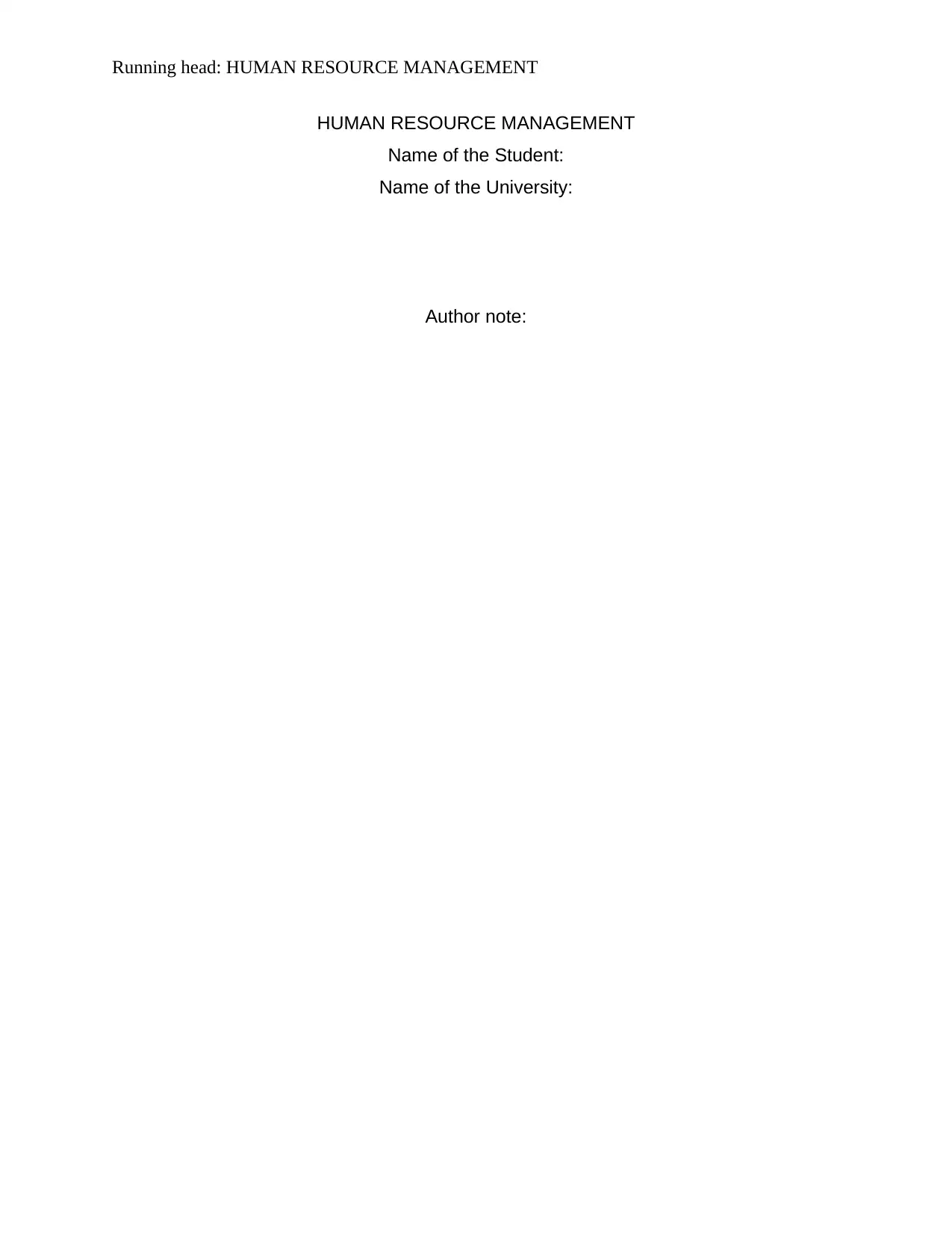
Running head: HUMAN RESOURCE MANAGEMENT
HUMAN RESOURCE MANAGEMENT
Name of the Student:
Name of the University:
Author note:
HUMAN RESOURCE MANAGEMENT
Name of the Student:
Name of the University:
Author note:
Paraphrase This Document
Need a fresh take? Get an instant paraphrase of this document with our AI Paraphraser
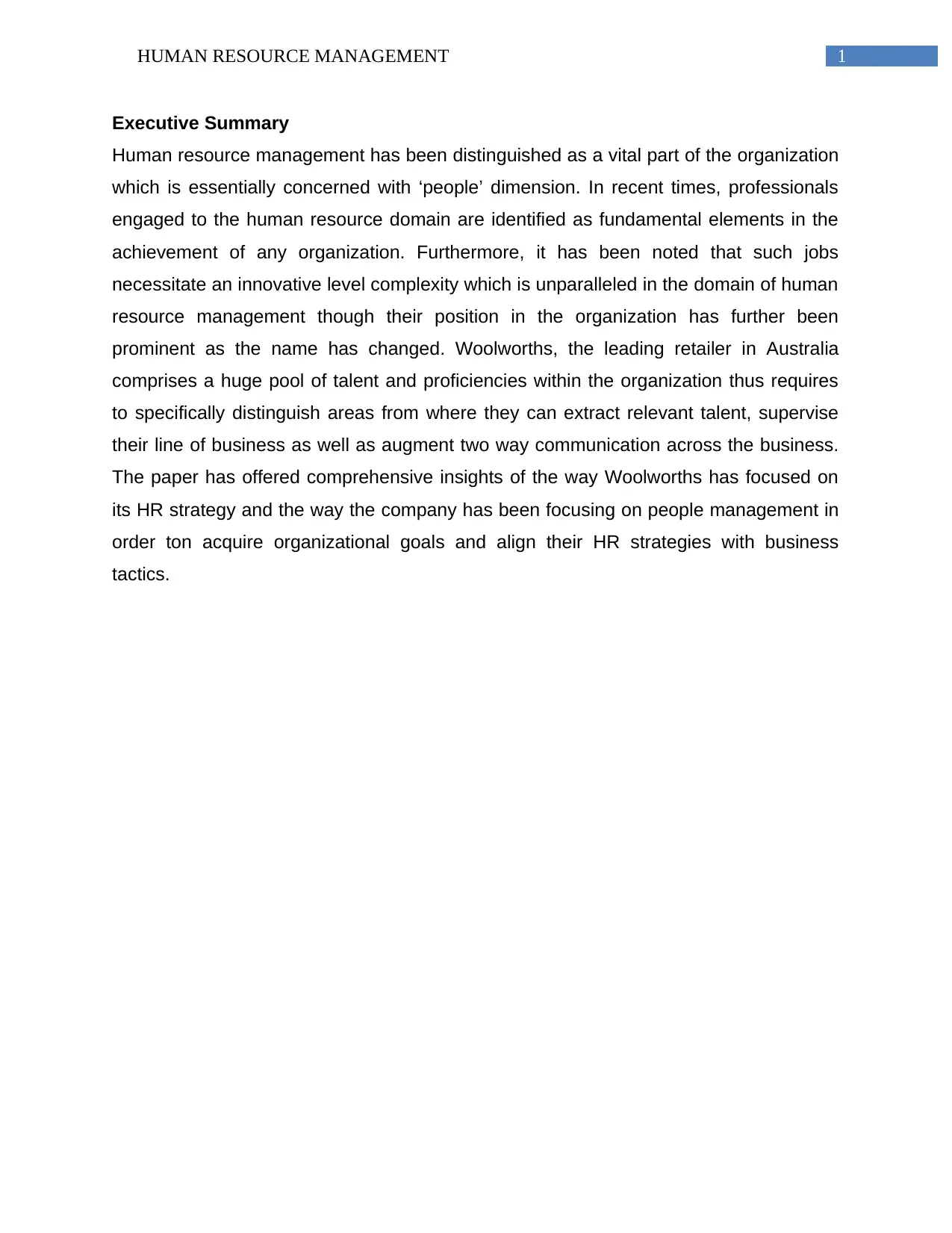
1HUMAN RESOURCE MANAGEMENT
Executive Summary
Human resource management has been distinguished as a vital part of the organization
which is essentially concerned with ‘people’ dimension. In recent times, professionals
engaged to the human resource domain are identified as fundamental elements in the
achievement of any organization. Furthermore, it has been noted that such jobs
necessitate an innovative level complexity which is unparalleled in the domain of human
resource management though their position in the organization has further been
prominent as the name has changed. Woolworths, the leading retailer in Australia
comprises a huge pool of talent and proficiencies within the organization thus requires
to specifically distinguish areas from where they can extract relevant talent, supervise
their line of business as well as augment two way communication across the business.
The paper has offered comprehensive insights of the way Woolworths has focused on
its HR strategy and the way the company has been focusing on people management in
order ton acquire organizational goals and align their HR strategies with business
tactics.
Executive Summary
Human resource management has been distinguished as a vital part of the organization
which is essentially concerned with ‘people’ dimension. In recent times, professionals
engaged to the human resource domain are identified as fundamental elements in the
achievement of any organization. Furthermore, it has been noted that such jobs
necessitate an innovative level complexity which is unparalleled in the domain of human
resource management though their position in the organization has further been
prominent as the name has changed. Woolworths, the leading retailer in Australia
comprises a huge pool of talent and proficiencies within the organization thus requires
to specifically distinguish areas from where they can extract relevant talent, supervise
their line of business as well as augment two way communication across the business.
The paper has offered comprehensive insights of the way Woolworths has focused on
its HR strategy and the way the company has been focusing on people management in
order ton acquire organizational goals and align their HR strategies with business
tactics.
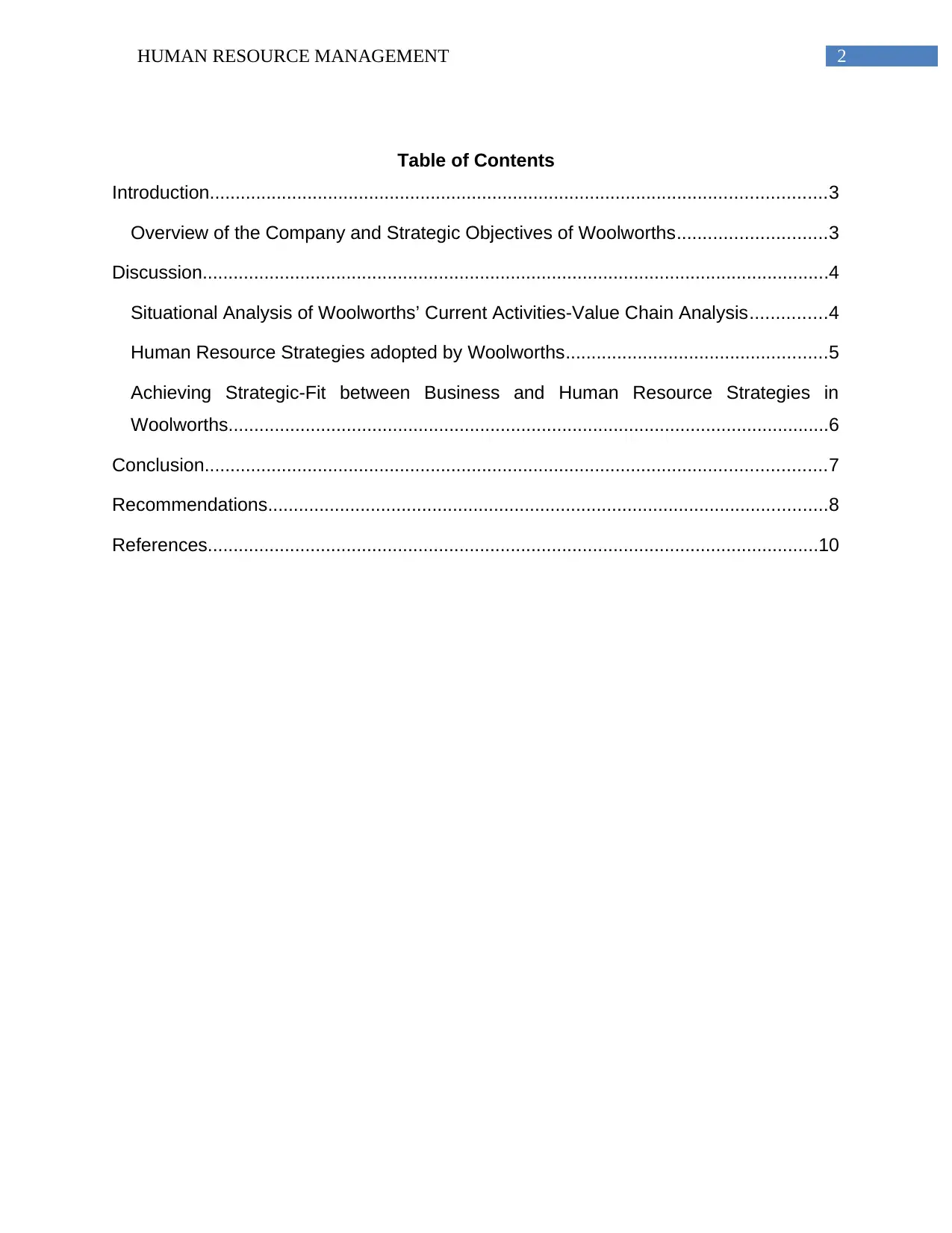
2HUMAN RESOURCE MANAGEMENT
Table of Contents
Introduction........................................................................................................................3
Overview of the Company and Strategic Objectives of Woolworths.............................3
Discussion..........................................................................................................................4
Situational Analysis of Woolworths’ Current Activities-Value Chain Analysis...............4
Human Resource Strategies adopted by Woolworths...................................................5
Achieving Strategic-Fit between Business and Human Resource Strategies in
Woolworths.....................................................................................................................6
Conclusion.........................................................................................................................7
Recommendations.............................................................................................................8
References.......................................................................................................................10
Table of Contents
Introduction........................................................................................................................3
Overview of the Company and Strategic Objectives of Woolworths.............................3
Discussion..........................................................................................................................4
Situational Analysis of Woolworths’ Current Activities-Value Chain Analysis...............4
Human Resource Strategies adopted by Woolworths...................................................5
Achieving Strategic-Fit between Business and Human Resource Strategies in
Woolworths.....................................................................................................................6
Conclusion.........................................................................................................................7
Recommendations.............................................................................................................8
References.......................................................................................................................10
⊘ This is a preview!⊘
Do you want full access?
Subscribe today to unlock all pages.

Trusted by 1+ million students worldwide
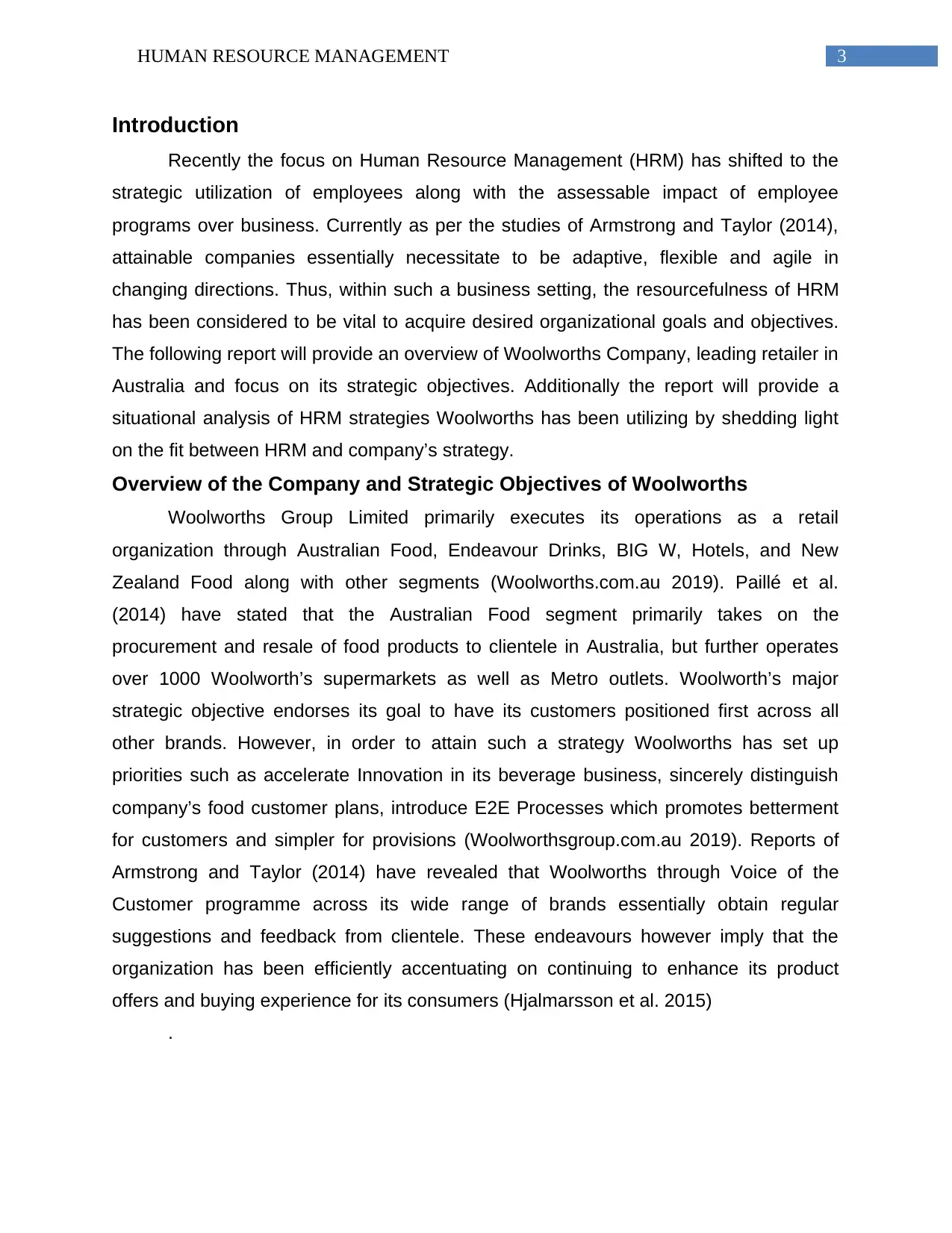
3HUMAN RESOURCE MANAGEMENT
Introduction
Recently the focus on Human Resource Management (HRM) has shifted to the
strategic utilization of employees along with the assessable impact of employee
programs over business. Currently as per the studies of Armstrong and Taylor (2014),
attainable companies essentially necessitate to be adaptive, flexible and agile in
changing directions. Thus, within such a business setting, the resourcefulness of HRM
has been considered to be vital to acquire desired organizational goals and objectives.
The following report will provide an overview of Woolworths Company, leading retailer in
Australia and focus on its strategic objectives. Additionally the report will provide a
situational analysis of HRM strategies Woolworths has been utilizing by shedding light
on the fit between HRM and company’s strategy.
Overview of the Company and Strategic Objectives of Woolworths
Woolworths Group Limited primarily executes its operations as a retail
organization through Australian Food, Endeavour Drinks, BIG W, Hotels, and New
Zealand Food along with other segments (Woolworths.com.au 2019). Paillé et al.
(2014) have stated that the Australian Food segment primarily takes on the
procurement and resale of food products to clientele in Australia, but further operates
over 1000 Woolworth’s supermarkets as well as Metro outlets. Woolworth’s major
strategic objective endorses its goal to have its customers positioned first across all
other brands. However, in order to attain such a strategy Woolworths has set up
priorities such as accelerate Innovation in its beverage business, sincerely distinguish
company’s food customer plans, introduce E2E Processes which promotes betterment
for customers and simpler for provisions (Woolworthsgroup.com.au 2019). Reports of
Armstrong and Taylor (2014) have revealed that Woolworths through Voice of the
Customer programme across its wide range of brands essentially obtain regular
suggestions and feedback from clientele. These endeavours however imply that the
organization has been efficiently accentuating on continuing to enhance its product
offers and buying experience for its consumers (Hjalmarsson et al. 2015)
.
Introduction
Recently the focus on Human Resource Management (HRM) has shifted to the
strategic utilization of employees along with the assessable impact of employee
programs over business. Currently as per the studies of Armstrong and Taylor (2014),
attainable companies essentially necessitate to be adaptive, flexible and agile in
changing directions. Thus, within such a business setting, the resourcefulness of HRM
has been considered to be vital to acquire desired organizational goals and objectives.
The following report will provide an overview of Woolworths Company, leading retailer in
Australia and focus on its strategic objectives. Additionally the report will provide a
situational analysis of HRM strategies Woolworths has been utilizing by shedding light
on the fit between HRM and company’s strategy.
Overview of the Company and Strategic Objectives of Woolworths
Woolworths Group Limited primarily executes its operations as a retail
organization through Australian Food, Endeavour Drinks, BIG W, Hotels, and New
Zealand Food along with other segments (Woolworths.com.au 2019). Paillé et al.
(2014) have stated that the Australian Food segment primarily takes on the
procurement and resale of food products to clientele in Australia, but further operates
over 1000 Woolworth’s supermarkets as well as Metro outlets. Woolworth’s major
strategic objective endorses its goal to have its customers positioned first across all
other brands. However, in order to attain such a strategy Woolworths has set up
priorities such as accelerate Innovation in its beverage business, sincerely distinguish
company’s food customer plans, introduce E2E Processes which promotes betterment
for customers and simpler for provisions (Woolworthsgroup.com.au 2019). Reports of
Armstrong and Taylor (2014) have revealed that Woolworths through Voice of the
Customer programme across its wide range of brands essentially obtain regular
suggestions and feedback from clientele. These endeavours however imply that the
organization has been efficiently accentuating on continuing to enhance its product
offers and buying experience for its consumers (Hjalmarsson et al. 2015)
.
Paraphrase This Document
Need a fresh take? Get an instant paraphrase of this document with our AI Paraphraser
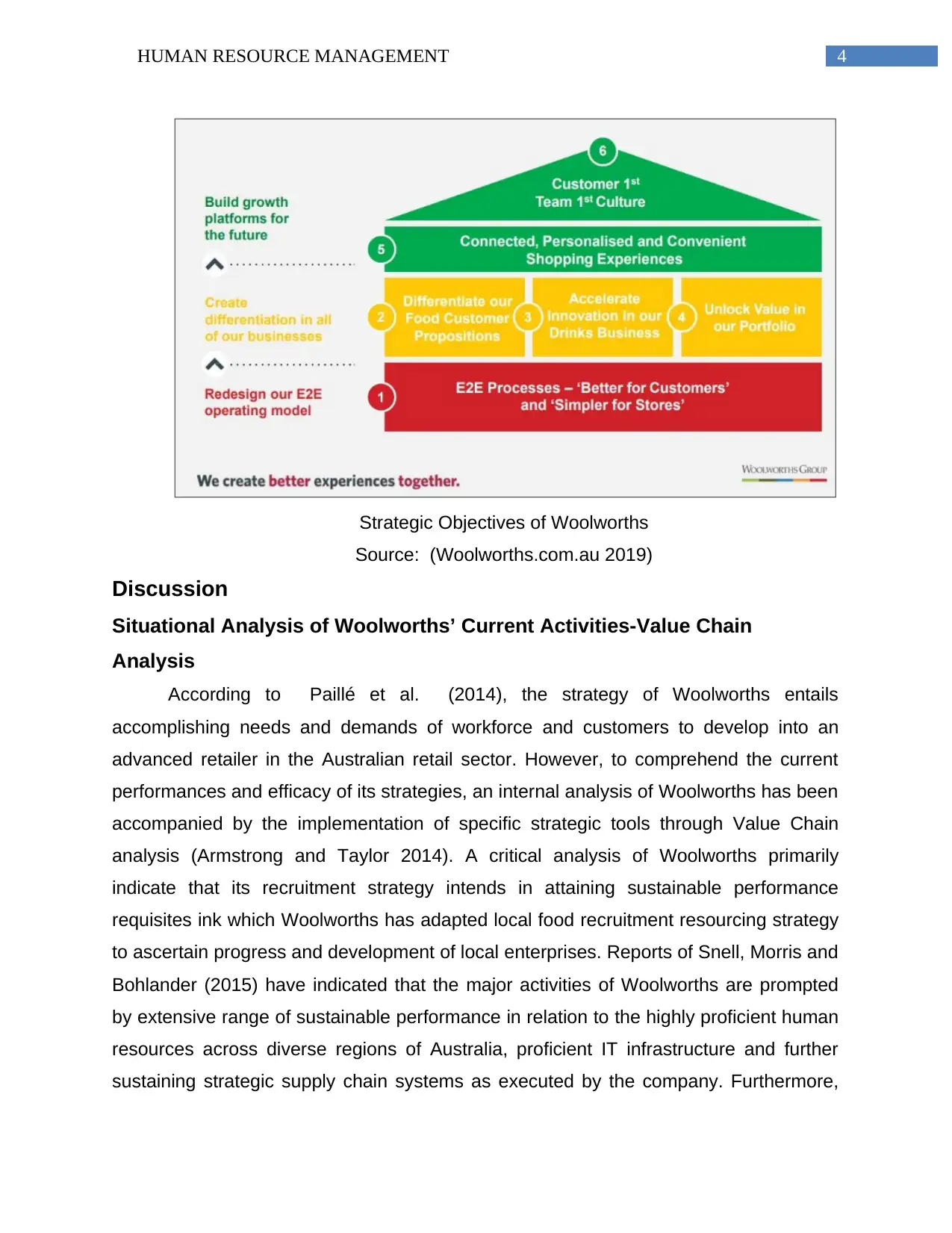
4HUMAN RESOURCE MANAGEMENT
Strategic Objectives of Woolworths
Source: (Woolworths.com.au 2019)
Discussion
Situational Analysis of Woolworths’ Current Activities-Value Chain
Analysis
According to Paillé et al. (2014), the strategy of Woolworths entails
accomplishing needs and demands of workforce and customers to develop into an
advanced retailer in the Australian retail sector. However, to comprehend the current
performances and efficacy of its strategies, an internal analysis of Woolworths has been
accompanied by the implementation of specific strategic tools through Value Chain
analysis (Armstrong and Taylor 2014). A critical analysis of Woolworths primarily
indicate that its recruitment strategy intends in attaining sustainable performance
requisites ink which Woolworths has adapted local food recruitment resourcing strategy
to ascertain progress and development of local enterprises. Reports of Snell, Morris and
Bohlander (2015) have indicated that the major activities of Woolworths are prompted
by extensive range of sustainable performance in relation to the highly proficient human
resources across diverse regions of Australia, proficient IT infrastructure and further
sustaining strategic supply chain systems as executed by the company. Furthermore,
Strategic Objectives of Woolworths
Source: (Woolworths.com.au 2019)
Discussion
Situational Analysis of Woolworths’ Current Activities-Value Chain
Analysis
According to Paillé et al. (2014), the strategy of Woolworths entails
accomplishing needs and demands of workforce and customers to develop into an
advanced retailer in the Australian retail sector. However, to comprehend the current
performances and efficacy of its strategies, an internal analysis of Woolworths has been
accompanied by the implementation of specific strategic tools through Value Chain
analysis (Armstrong and Taylor 2014). A critical analysis of Woolworths primarily
indicate that its recruitment strategy intends in attaining sustainable performance
requisites ink which Woolworths has adapted local food recruitment resourcing strategy
to ascertain progress and development of local enterprises. Reports of Snell, Morris and
Bohlander (2015) have indicated that the major activities of Woolworths are prompted
by extensive range of sustainable performance in relation to the highly proficient human
resources across diverse regions of Australia, proficient IT infrastructure and further
sustaining strategic supply chain systems as executed by the company. Furthermore,
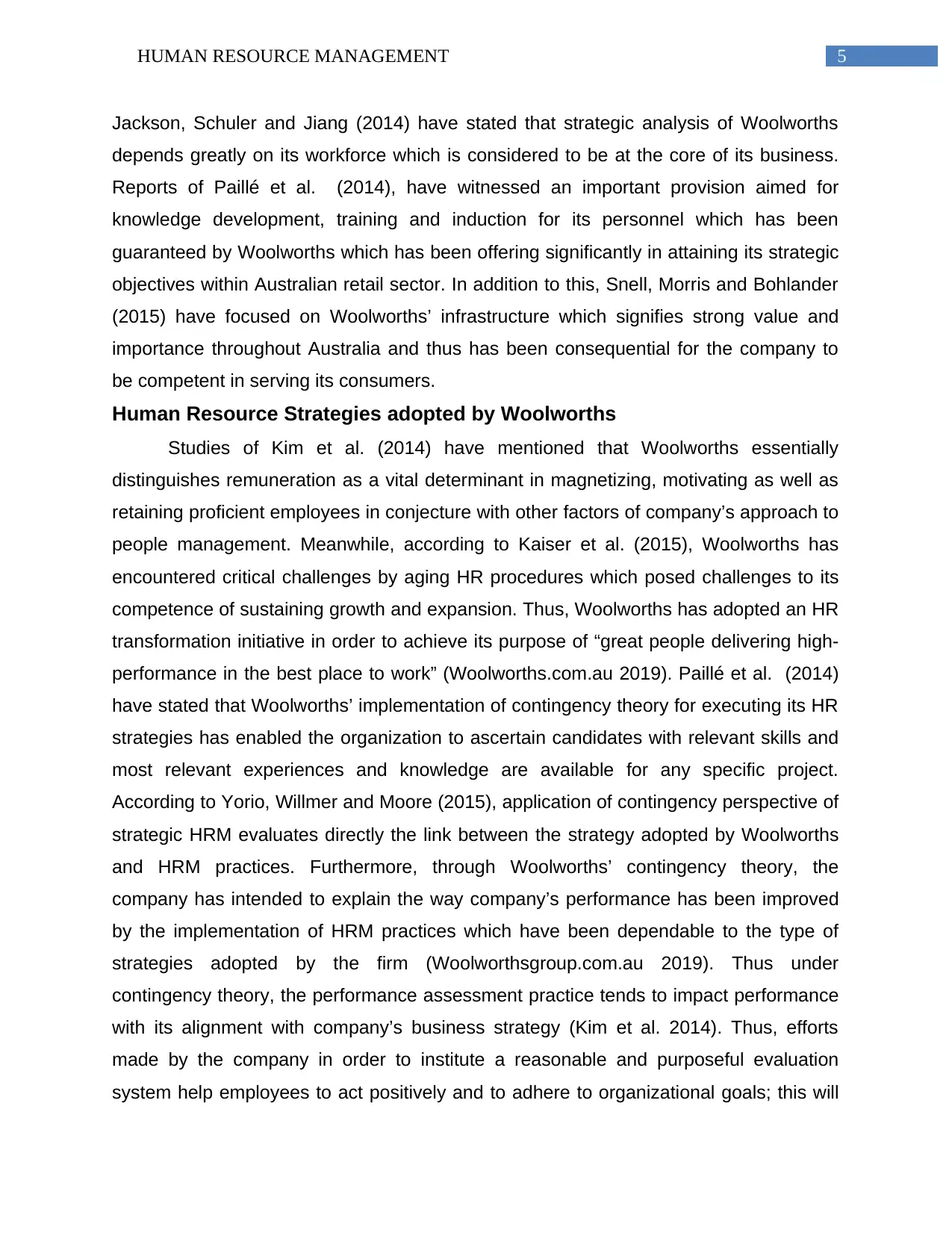
5HUMAN RESOURCE MANAGEMENT
Jackson, Schuler and Jiang (2014) have stated that strategic analysis of Woolworths
depends greatly on its workforce which is considered to be at the core of its business.
Reports of Paillé et al. (2014), have witnessed an important provision aimed for
knowledge development, training and induction for its personnel which has been
guaranteed by Woolworths which has been offering significantly in attaining its strategic
objectives within Australian retail sector. In addition to this, Snell, Morris and Bohlander
(2015) have focused on Woolworths’ infrastructure which signifies strong value and
importance throughout Australia and thus has been consequential for the company to
be competent in serving its consumers.
Human Resource Strategies adopted by Woolworths
Studies of Kim et al. (2014) have mentioned that Woolworths essentially
distinguishes remuneration as a vital determinant in magnetizing, motivating as well as
retaining proficient employees in conjecture with other factors of company’s approach to
people management. Meanwhile, according to Kaiser et al. (2015), Woolworths has
encountered critical challenges by aging HR procedures which posed challenges to its
competence of sustaining growth and expansion. Thus, Woolworths has adopted an HR
transformation initiative in order to achieve its purpose of “great people delivering high-
performance in the best place to work” (Woolworths.com.au 2019). Paillé et al. (2014)
have stated that Woolworths’ implementation of contingency theory for executing its HR
strategies has enabled the organization to ascertain candidates with relevant skills and
most relevant experiences and knowledge are available for any specific project.
According to Yorio, Willmer and Moore (2015), application of contingency perspective of
strategic HRM evaluates directly the link between the strategy adopted by Woolworths
and HRM practices. Furthermore, through Woolworths’ contingency theory, the
company has intended to explain the way company’s performance has been improved
by the implementation of HRM practices which have been dependable to the type of
strategies adopted by the firm (Woolworthsgroup.com.au 2019). Thus under
contingency theory, the performance assessment practice tends to impact performance
with its alignment with company’s business strategy (Kim et al. 2014). Thus, efforts
made by the company in order to institute a reasonable and purposeful evaluation
system help employees to act positively and to adhere to organizational goals; this will
Jackson, Schuler and Jiang (2014) have stated that strategic analysis of Woolworths
depends greatly on its workforce which is considered to be at the core of its business.
Reports of Paillé et al. (2014), have witnessed an important provision aimed for
knowledge development, training and induction for its personnel which has been
guaranteed by Woolworths which has been offering significantly in attaining its strategic
objectives within Australian retail sector. In addition to this, Snell, Morris and Bohlander
(2015) have focused on Woolworths’ infrastructure which signifies strong value and
importance throughout Australia and thus has been consequential for the company to
be competent in serving its consumers.
Human Resource Strategies adopted by Woolworths
Studies of Kim et al. (2014) have mentioned that Woolworths essentially
distinguishes remuneration as a vital determinant in magnetizing, motivating as well as
retaining proficient employees in conjecture with other factors of company’s approach to
people management. Meanwhile, according to Kaiser et al. (2015), Woolworths has
encountered critical challenges by aging HR procedures which posed challenges to its
competence of sustaining growth and expansion. Thus, Woolworths has adopted an HR
transformation initiative in order to achieve its purpose of “great people delivering high-
performance in the best place to work” (Woolworths.com.au 2019). Paillé et al. (2014)
have stated that Woolworths’ implementation of contingency theory for executing its HR
strategies has enabled the organization to ascertain candidates with relevant skills and
most relevant experiences and knowledge are available for any specific project.
According to Yorio, Willmer and Moore (2015), application of contingency perspective of
strategic HRM evaluates directly the link between the strategy adopted by Woolworths
and HRM practices. Furthermore, through Woolworths’ contingency theory, the
company has intended to explain the way company’s performance has been improved
by the implementation of HRM practices which have been dependable to the type of
strategies adopted by the firm (Woolworthsgroup.com.au 2019). Thus under
contingency theory, the performance assessment practice tends to impact performance
with its alignment with company’s business strategy (Kim et al. 2014). Thus, efforts
made by the company in order to institute a reasonable and purposeful evaluation
system help employees to act positively and to adhere to organizational goals; this will
⊘ This is a preview!⊘
Do you want full access?
Subscribe today to unlock all pages.

Trusted by 1+ million students worldwide
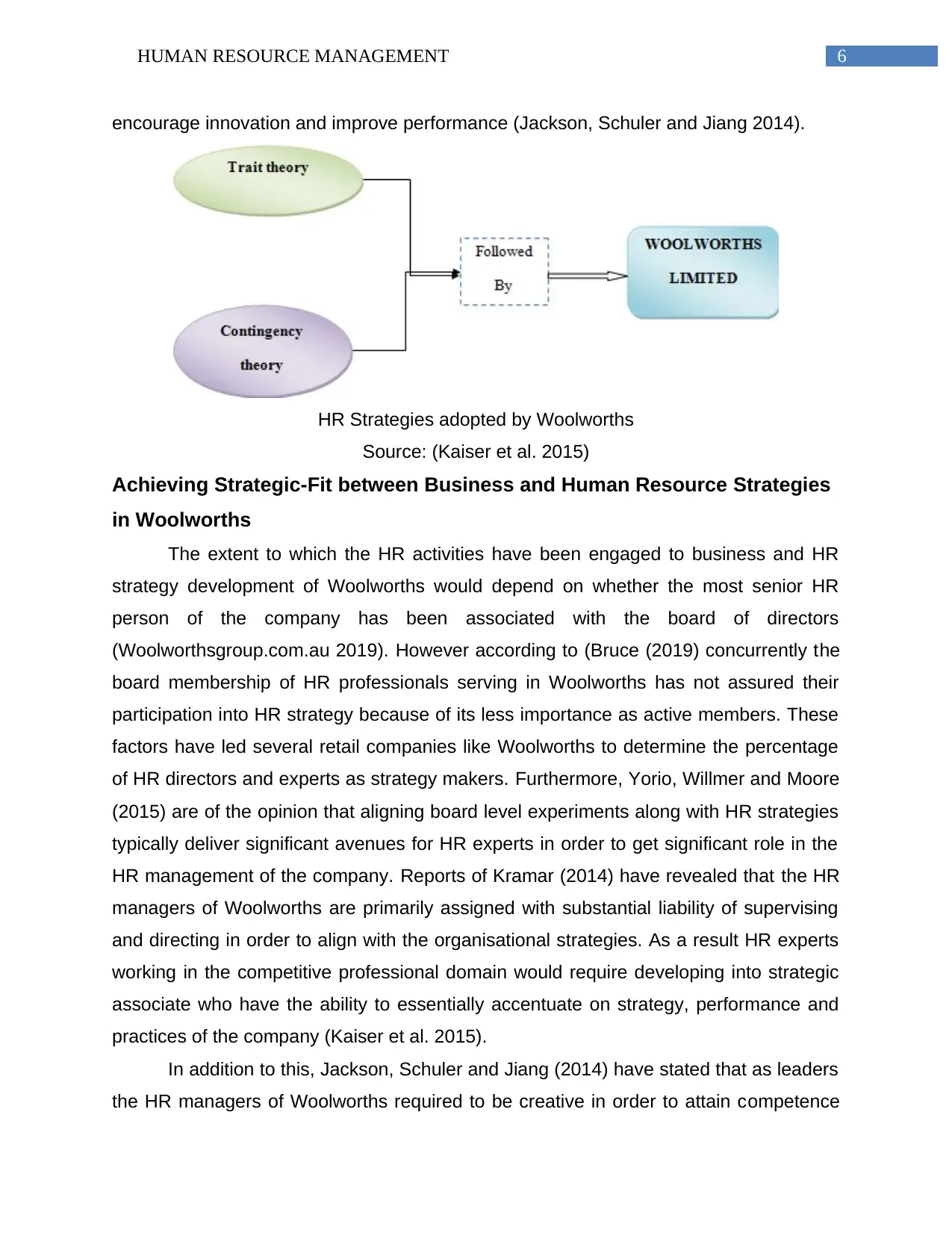
6HUMAN RESOURCE MANAGEMENT
encourage innovation and improve performance (Jackson, Schuler and Jiang 2014).
HR Strategies adopted by Woolworths
Source: (Kaiser et al. 2015)
Achieving Strategic-Fit between Business and Human Resource Strategies
in Woolworths
The extent to which the HR activities have been engaged to business and HR
strategy development of Woolworths would depend on whether the most senior HR
person of the company has been associated with the board of directors
(Woolworthsgroup.com.au 2019). However according to (Bruce (2019) concurrently the
board membership of HR professionals serving in Woolworths has not assured their
participation into HR strategy because of its less importance as active members. These
factors have led several retail companies like Woolworths to determine the percentage
of HR directors and experts as strategy makers. Furthermore, Yorio, Willmer and Moore
(2015) are of the opinion that aligning board level experiments along with HR strategies
typically deliver significant avenues for HR experts in order to get significant role in the
HR management of the company. Reports of Kramar (2014) have revealed that the HR
managers of Woolworths are primarily assigned with substantial liability of supervising
and directing in order to align with the organisational strategies. As a result HR experts
working in the competitive professional domain would require developing into strategic
associate who have the ability to essentially accentuate on strategy, performance and
practices of the company (Kaiser et al. 2015).
In addition to this, Jackson, Schuler and Jiang (2014) have stated that as leaders
the HR managers of Woolworths required to be creative in order to attain competence
encourage innovation and improve performance (Jackson, Schuler and Jiang 2014).
HR Strategies adopted by Woolworths
Source: (Kaiser et al. 2015)
Achieving Strategic-Fit between Business and Human Resource Strategies
in Woolworths
The extent to which the HR activities have been engaged to business and HR
strategy development of Woolworths would depend on whether the most senior HR
person of the company has been associated with the board of directors
(Woolworthsgroup.com.au 2019). However according to (Bruce (2019) concurrently the
board membership of HR professionals serving in Woolworths has not assured their
participation into HR strategy because of its less importance as active members. These
factors have led several retail companies like Woolworths to determine the percentage
of HR directors and experts as strategy makers. Furthermore, Yorio, Willmer and Moore
(2015) are of the opinion that aligning board level experiments along with HR strategies
typically deliver significant avenues for HR experts in order to get significant role in the
HR management of the company. Reports of Kramar (2014) have revealed that the HR
managers of Woolworths are primarily assigned with substantial liability of supervising
and directing in order to align with the organisational strategies. As a result HR experts
working in the competitive professional domain would require developing into strategic
associate who have the ability to essentially accentuate on strategy, performance and
practices of the company (Kaiser et al. 2015).
In addition to this, Jackson, Schuler and Jiang (2014) have stated that as leaders
the HR managers of Woolworths required to be creative in order to attain competence
Paraphrase This Document
Need a fresh take? Get an instant paraphrase of this document with our AI Paraphraser
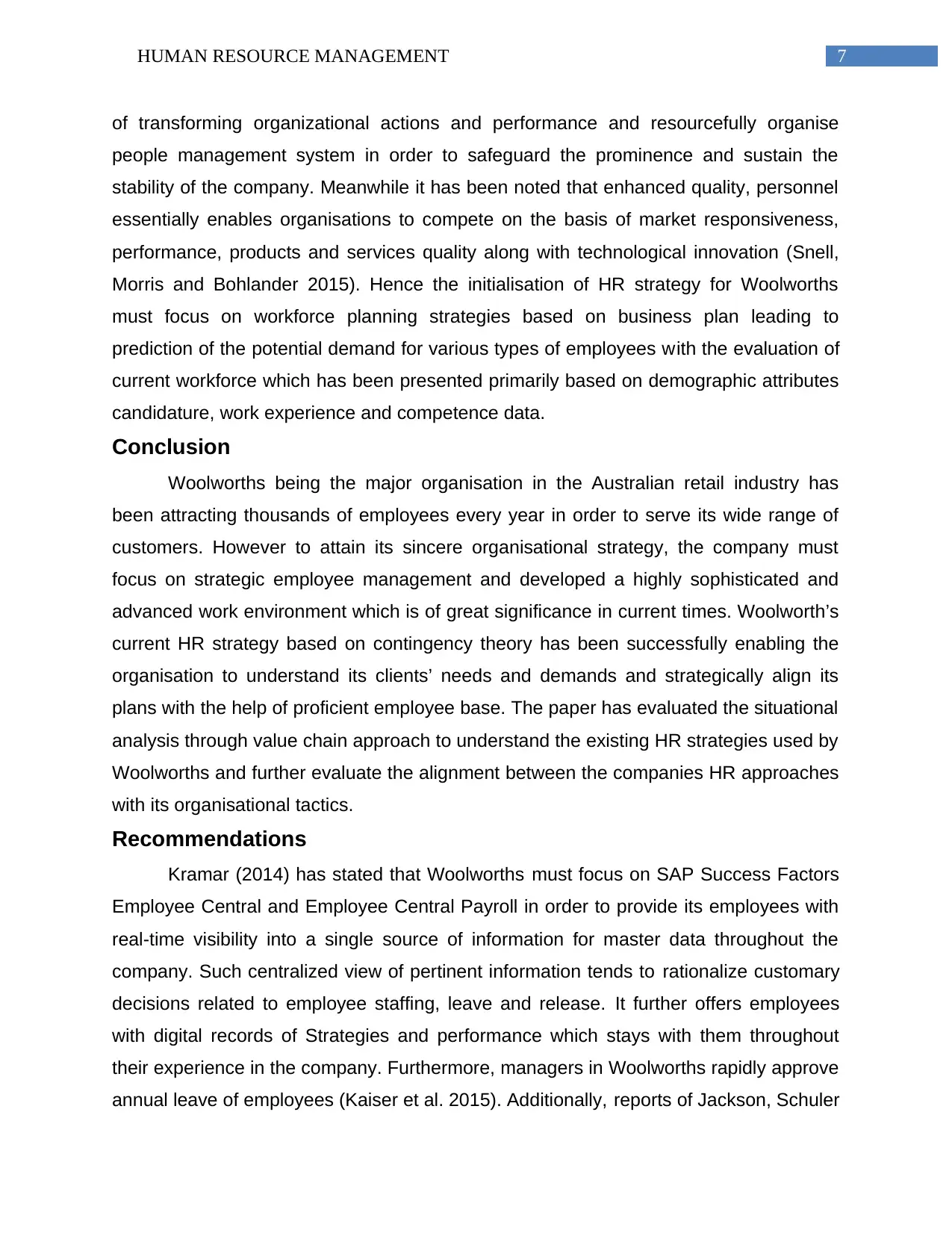
7HUMAN RESOURCE MANAGEMENT
of transforming organizational actions and performance and resourcefully organise
people management system in order to safeguard the prominence and sustain the
stability of the company. Meanwhile it has been noted that enhanced quality, personnel
essentially enables organisations to compete on the basis of market responsiveness,
performance, products and services quality along with technological innovation (Snell,
Morris and Bohlander 2015). Hence the initialisation of HR strategy for Woolworths
must focus on workforce planning strategies based on business plan leading to
prediction of the potential demand for various types of employees with the evaluation of
current workforce which has been presented primarily based on demographic attributes
candidature, work experience and competence data.
Conclusion
Woolworths being the major organisation in the Australian retail industry has
been attracting thousands of employees every year in order to serve its wide range of
customers. However to attain its sincere organisational strategy, the company must
focus on strategic employee management and developed a highly sophisticated and
advanced work environment which is of great significance in current times. Woolworth’s
current HR strategy based on contingency theory has been successfully enabling the
organisation to understand its clients’ needs and demands and strategically align its
plans with the help of proficient employee base. The paper has evaluated the situational
analysis through value chain approach to understand the existing HR strategies used by
Woolworths and further evaluate the alignment between the companies HR approaches
with its organisational tactics.
Recommendations
Kramar (2014) has stated that Woolworths must focus on SAP Success Factors
Employee Central and Employee Central Payroll in order to provide its employees with
real-time visibility into a single source of information for master data throughout the
company. Such centralized view of pertinent information tends to rationalize customary
decisions related to employee staffing, leave and release. It further offers employees
with digital records of Strategies and performance which stays with them throughout
their experience in the company. Furthermore, managers in Woolworths rapidly approve
annual leave of employees (Kaiser et al. 2015). Additionally, reports of Jackson, Schuler
of transforming organizational actions and performance and resourcefully organise
people management system in order to safeguard the prominence and sustain the
stability of the company. Meanwhile it has been noted that enhanced quality, personnel
essentially enables organisations to compete on the basis of market responsiveness,
performance, products and services quality along with technological innovation (Snell,
Morris and Bohlander 2015). Hence the initialisation of HR strategy for Woolworths
must focus on workforce planning strategies based on business plan leading to
prediction of the potential demand for various types of employees with the evaluation of
current workforce which has been presented primarily based on demographic attributes
candidature, work experience and competence data.
Conclusion
Woolworths being the major organisation in the Australian retail industry has
been attracting thousands of employees every year in order to serve its wide range of
customers. However to attain its sincere organisational strategy, the company must
focus on strategic employee management and developed a highly sophisticated and
advanced work environment which is of great significance in current times. Woolworth’s
current HR strategy based on contingency theory has been successfully enabling the
organisation to understand its clients’ needs and demands and strategically align its
plans with the help of proficient employee base. The paper has evaluated the situational
analysis through value chain approach to understand the existing HR strategies used by
Woolworths and further evaluate the alignment between the companies HR approaches
with its organisational tactics.
Recommendations
Kramar (2014) has stated that Woolworths must focus on SAP Success Factors
Employee Central and Employee Central Payroll in order to provide its employees with
real-time visibility into a single source of information for master data throughout the
company. Such centralized view of pertinent information tends to rationalize customary
decisions related to employee staffing, leave and release. It further offers employees
with digital records of Strategies and performance which stays with them throughout
their experience in the company. Furthermore, managers in Woolworths rapidly approve
annual leave of employees (Kaiser et al. 2015). Additionally, reports of Jackson, Schuler
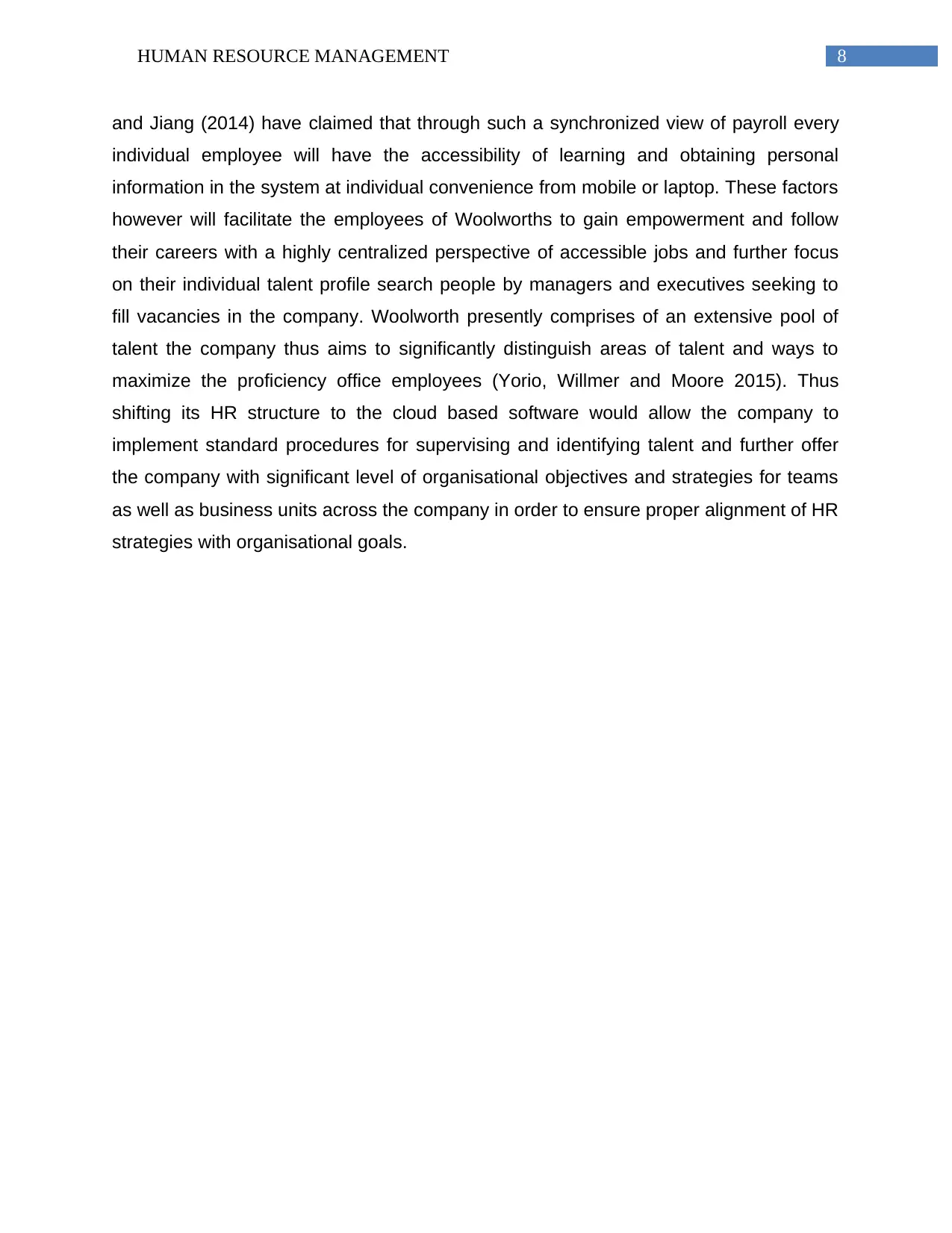
8HUMAN RESOURCE MANAGEMENT
and Jiang (2014) have claimed that through such a synchronized view of payroll every
individual employee will have the accessibility of learning and obtaining personal
information in the system at individual convenience from mobile or laptop. These factors
however will facilitate the employees of Woolworths to gain empowerment and follow
their careers with a highly centralized perspective of accessible jobs and further focus
on their individual talent profile search people by managers and executives seeking to
fill vacancies in the company. Woolworth presently comprises of an extensive pool of
talent the company thus aims to significantly distinguish areas of talent and ways to
maximize the proficiency office employees (Yorio, Willmer and Moore 2015). Thus
shifting its HR structure to the cloud based software would allow the company to
implement standard procedures for supervising and identifying talent and further offer
the company with significant level of organisational objectives and strategies for teams
as well as business units across the company in order to ensure proper alignment of HR
strategies with organisational goals.
and Jiang (2014) have claimed that through such a synchronized view of payroll every
individual employee will have the accessibility of learning and obtaining personal
information in the system at individual convenience from mobile or laptop. These factors
however will facilitate the employees of Woolworths to gain empowerment and follow
their careers with a highly centralized perspective of accessible jobs and further focus
on their individual talent profile search people by managers and executives seeking to
fill vacancies in the company. Woolworth presently comprises of an extensive pool of
talent the company thus aims to significantly distinguish areas of talent and ways to
maximize the proficiency office employees (Yorio, Willmer and Moore 2015). Thus
shifting its HR structure to the cloud based software would allow the company to
implement standard procedures for supervising and identifying talent and further offer
the company with significant level of organisational objectives and strategies for teams
as well as business units across the company in order to ensure proper alignment of HR
strategies with organisational goals.
⊘ This is a preview!⊘
Do you want full access?
Subscribe today to unlock all pages.

Trusted by 1+ million students worldwide
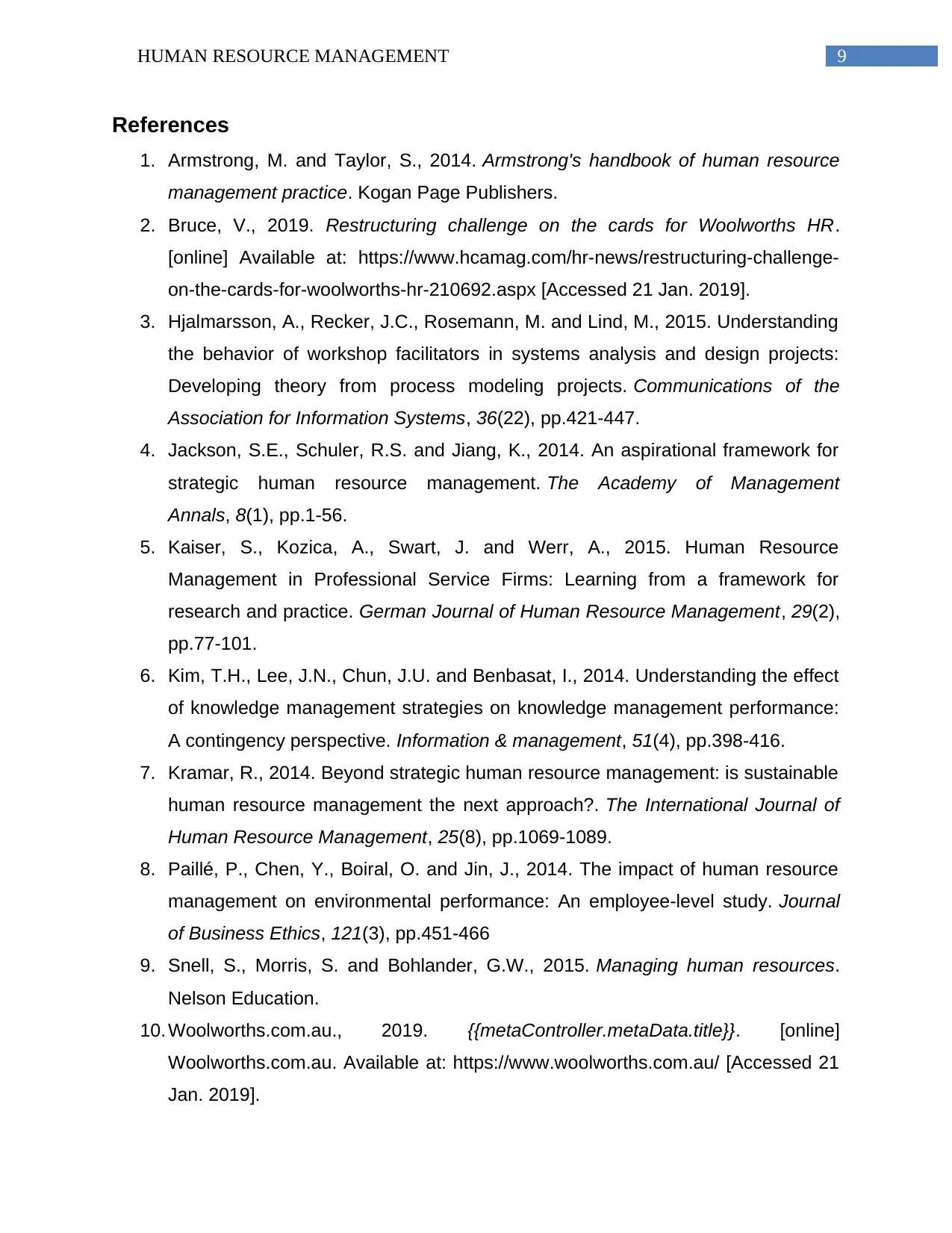
9HUMAN RESOURCE MANAGEMENT
References
1. Armstrong, M. and Taylor, S., 2014. Armstrong's handbook of human resource
management practice. Kogan Page Publishers.
2. Bruce, V., 2019. Restructuring challenge on the cards for Woolworths HR.
[online] Available at: https://www.hcamag.com/hr-news/restructuring-challenge-
on-the-cards-for-woolworths-hr-210692.aspx [Accessed 21 Jan. 2019].
3. Hjalmarsson, A., Recker, J.C., Rosemann, M. and Lind, M., 2015. Understanding
the behavior of workshop facilitators in systems analysis and design projects:
Developing theory from process modeling projects. Communications of the
Association for Information Systems, 36(22), pp.421-447.
4. Jackson, S.E., Schuler, R.S. and Jiang, K., 2014. An aspirational framework for
strategic human resource management. The Academy of Management
Annals, 8(1), pp.1-56.
5. Kaiser, S., Kozica, A., Swart, J. and Werr, A., 2015. Human Resource
Management in Professional Service Firms: Learning from a framework for
research and practice. German Journal of Human Resource Management, 29(2),
pp.77-101.
6. Kim, T.H., Lee, J.N., Chun, J.U. and Benbasat, I., 2014. Understanding the effect
of knowledge management strategies on knowledge management performance:
A contingency perspective. Information & management, 51(4), pp.398-416.
7. Kramar, R., 2014. Beyond strategic human resource management: is sustainable
human resource management the next approach?. The International Journal of
Human Resource Management, 25(8), pp.1069-1089.
8. Paillé, P., Chen, Y., Boiral, O. and Jin, J., 2014. The impact of human resource
management on environmental performance: An employee-level study. Journal
of Business Ethics, 121(3), pp.451-466
9. Snell, S., Morris, S. and Bohlander, G.W., 2015. Managing human resources.
Nelson Education.
10. Woolworths.com.au., 2019. {{metaController.metaData.title}}. [online]
Woolworths.com.au. Available at: https://www.woolworths.com.au/ [Accessed 21
Jan. 2019].
References
1. Armstrong, M. and Taylor, S., 2014. Armstrong's handbook of human resource
management practice. Kogan Page Publishers.
2. Bruce, V., 2019. Restructuring challenge on the cards for Woolworths HR.
[online] Available at: https://www.hcamag.com/hr-news/restructuring-challenge-
on-the-cards-for-woolworths-hr-210692.aspx [Accessed 21 Jan. 2019].
3. Hjalmarsson, A., Recker, J.C., Rosemann, M. and Lind, M., 2015. Understanding
the behavior of workshop facilitators in systems analysis and design projects:
Developing theory from process modeling projects. Communications of the
Association for Information Systems, 36(22), pp.421-447.
4. Jackson, S.E., Schuler, R.S. and Jiang, K., 2014. An aspirational framework for
strategic human resource management. The Academy of Management
Annals, 8(1), pp.1-56.
5. Kaiser, S., Kozica, A., Swart, J. and Werr, A., 2015. Human Resource
Management in Professional Service Firms: Learning from a framework for
research and practice. German Journal of Human Resource Management, 29(2),
pp.77-101.
6. Kim, T.H., Lee, J.N., Chun, J.U. and Benbasat, I., 2014. Understanding the effect
of knowledge management strategies on knowledge management performance:
A contingency perspective. Information & management, 51(4), pp.398-416.
7. Kramar, R., 2014. Beyond strategic human resource management: is sustainable
human resource management the next approach?. The International Journal of
Human Resource Management, 25(8), pp.1069-1089.
8. Paillé, P., Chen, Y., Boiral, O. and Jin, J., 2014. The impact of human resource
management on environmental performance: An employee-level study. Journal
of Business Ethics, 121(3), pp.451-466
9. Snell, S., Morris, S. and Bohlander, G.W., 2015. Managing human resources.
Nelson Education.
10. Woolworths.com.au., 2019. {{metaController.metaData.title}}. [online]
Woolworths.com.au. Available at: https://www.woolworths.com.au/ [Accessed 21
Jan. 2019].
Paraphrase This Document
Need a fresh take? Get an instant paraphrase of this document with our AI Paraphraser
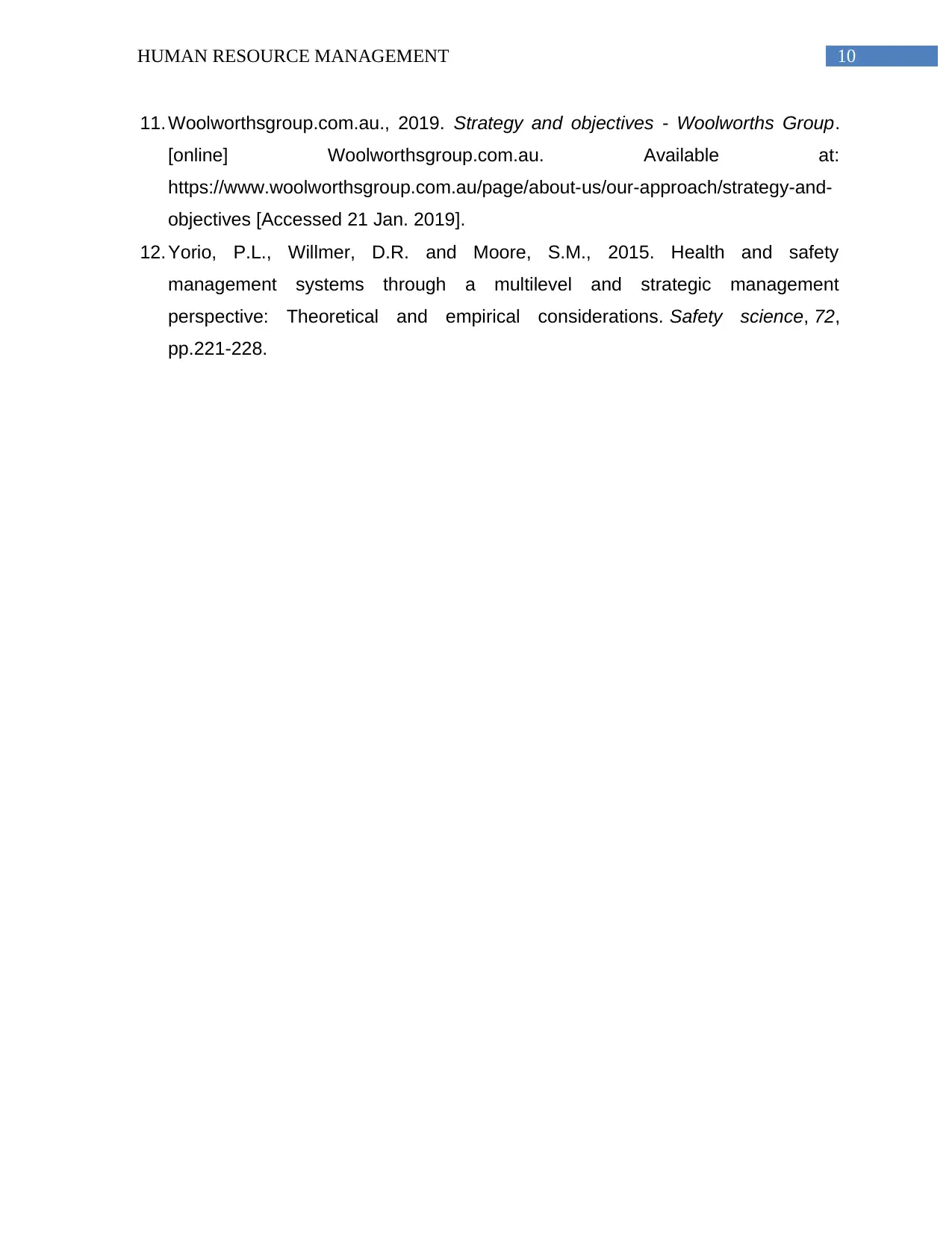
10HUMAN RESOURCE MANAGEMENT
11. Woolworthsgroup.com.au., 2019. Strategy and objectives - Woolworths Group.
[online] Woolworthsgroup.com.au. Available at:
https://www.woolworthsgroup.com.au/page/about-us/our-approach/strategy-and-
objectives [Accessed 21 Jan. 2019].
12. Yorio, P.L., Willmer, D.R. and Moore, S.M., 2015. Health and safety
management systems through a multilevel and strategic management
perspective: Theoretical and empirical considerations. Safety science, 72,
pp.221-228.
11. Woolworthsgroup.com.au., 2019. Strategy and objectives - Woolworths Group.
[online] Woolworthsgroup.com.au. Available at:
https://www.woolworthsgroup.com.au/page/about-us/our-approach/strategy-and-
objectives [Accessed 21 Jan. 2019].
12. Yorio, P.L., Willmer, D.R. and Moore, S.M., 2015. Health and safety
management systems through a multilevel and strategic management
perspective: Theoretical and empirical considerations. Safety science, 72,
pp.221-228.
1 out of 11
Related Documents
Your All-in-One AI-Powered Toolkit for Academic Success.
+13062052269
info@desklib.com
Available 24*7 on WhatsApp / Email
![[object Object]](/_next/static/media/star-bottom.7253800d.svg)
Unlock your academic potential
Copyright © 2020–2025 A2Z Services. All Rights Reserved. Developed and managed by ZUCOL.





